
Marathon Gold Reports Additional Positive Infill Drill Results at Berry Deposit, Valentine Gold Project

Marathon Gold Corporation (TSX: MOZ) is pleased to provide assay results on in-fill drill holes completed at the Berry Deposit, part of the Valentine Gold Project located in central Newfoundland.
During the 2022 exploration program, Marathon completed 20,931 metres of infill drilling at Berry, none of which was included in the Project’s June 2022 Mineral Resource Estimate. This in-fill program targeted gaps within the existing Berry drillhole dataset that are largely assumed to be un-mineralized waste in the Berry geological model but are within the conceptual pit shells used in the MRE. Success with this program has the potential to add mineable ounces to the Project’s mine plan. Assays from 9,811 metres of the 2022 drilling were previously reported (news releases dated June 15 and September 12, 2022). These latest results represent fire assay data from 5,490 metres of drilling in twenty-seven holes. Highlights include:
- VL-22-1258 intersected 5.01 g/t Au over 18 metres including 23.02 g/t Au over 1 metre and 17.90 g/t Au over 1 metre, and 4.28 g/t Au over 9 metres including 23.43 g/t Au over 1 metre, and 2.78 g/t Au over 6 metres including 11.72 g/t Au over 1 metre;
- VL-22-1256 intersected 3.50 g/t Au over 14 metres including 10.44 g/t Au over 1 metre.
- VL-22-1236 intersected 1.12 g/t Au over 46 metres.
- VL-22-1240 intersected 6.91 g/t Au over 7 metres including 12.86 g/t Au over 2 metres; and
- VL-22-1248 intersected 1.31 g/t Au over 29 metres including 16.76 g/t Au over 1 metre.
All quoted intersections comprise uncut gold assays in core lengths. All significant assay intervals are reported in Table 1.
Figure 1: The Berry Deposit (View SW), with drill holes completed during 2022 after the cut-off for the 2022 MRE. “Significant” intercepts (averaging >0.70 g/t Au) are shown in red (previously disclosed) or purple (today’s release). All visible intercepts occur outside the Quartz-Tourmaline-Pyrite-Vein mineralized domain (shown in yellow) and are predominantly outside the 2022 MRE.
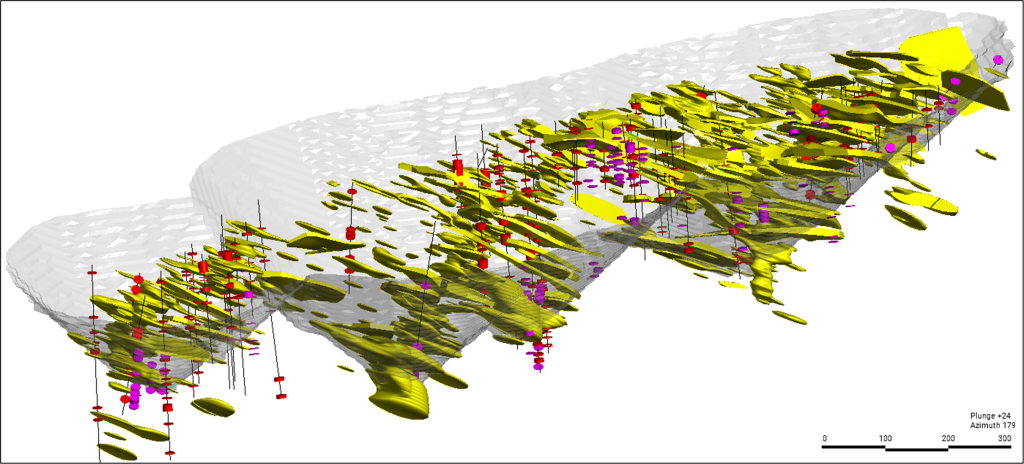
Matt Manson, President and CEO, commented: “With our news release of January 4th 2023, we set out the two principal priorities for our exploration at the Valentine Gold Project going forward: (1) delivering more ounces of mineable gold mineralization within the scope of the existing 3-pit mine plan, and (2) making new discoveries outside the scope of the mine plan. Today’s in-fill drill results at the Berry deposit should be understood in the context of the first of these priorities. As Figure 1 demonstrates, we continue to see long intersections of high-grade gold mineralization outside of Berry’s currently modeled mineralized domains including, from today’s results specifically, mineralization at the top and in the centre of the deposit. At depth, we are seeing long, continuous intercepts of gold mineralization associated with a sizeable domain of quartz-tourmaline-pyrite veining at the base of the mineral resource pit shell, as shown with DDH VL-22-1058 on Section 14100E, and illustrated in Figures 5 and 6. This large, mineralized area had been previously observed on adjacent sections, and was targeted with the 2022 drilling. All of these results support the proposition that Berry has the potential to deliver additional mineable gold ounces above what is currently estimated. We expect the final batch of 2022 Berry in-fill drill results to be reported shortly.”
Gold Mineralization at the Valentine Gold Project
Gold mineralization at the Valentine Gold Project is contained in Quartz-Tourmaline-Pyrite-Gold veins developed within granitoid rocks of the Valentine Lake Intrusive Suite on the hanging wall, or northwest, side of the Valentine Lake Shear Zone (Figure 2). Up to four orientations of veins have been measured, with shallowly southwest dipping “Set 1” QTP-Au veins observed to be dominant in both abundance and gold content. At the Leprechaun, Marathon and Berry Deposits, Set 1 QTP-Au veins form densely stacked corridors of mineralization referred to as “Main Zones”. The extent and scale of these mineralised corridors appear related to the size and frequency of sheared mafic dykes which extend northeast-southwest within the granitoid rocks, parallel to the shear zone.
Figure 2: Location Map, Valentine Gold Project
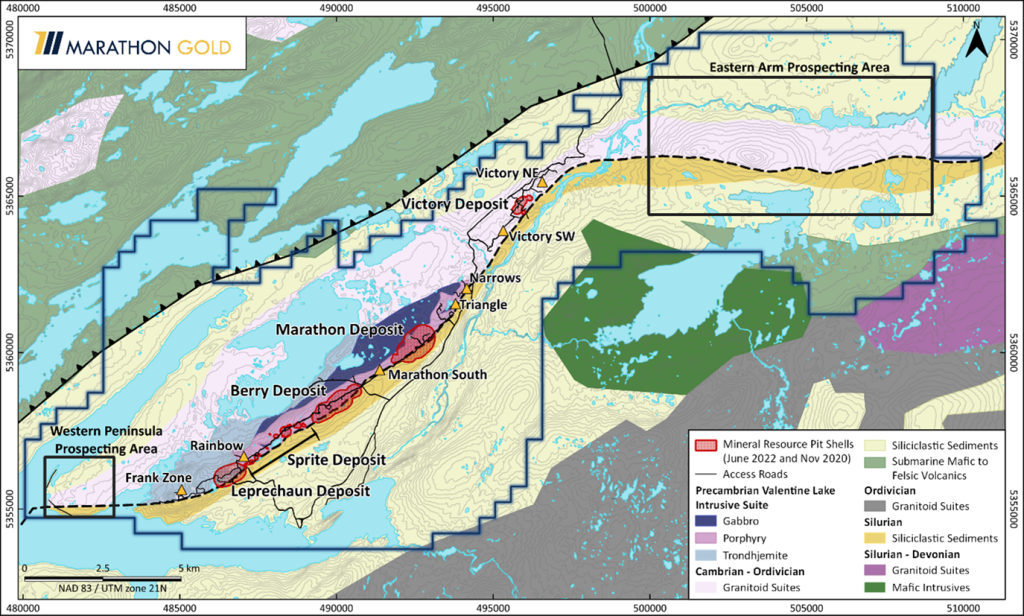
Berry Deposit Drill Results
The drill results released today are derived from twenty-seven drill holes located between sections 13240E and 14810E. The drill holes were located along the full 1.5 kilometre extent of the Berry Deposit, and located in areas of the Berry geological model that had been previously poorly defined with a view to identifying new areas of mineralisation or validating areas of mineralisation previously modelled with lower confidence. Twenty-two holes were located in the western hanging-wall area of the deposit, one was located in the central hanging-wall area, and four were located in the eastern hanging-wall area (Figure 3).
Seventeen holes were oriented steeply to the northwest testing for Main Zone-type stacked QTP-Au mineralization in “Set 1” vein orientations. Ten holes were oriented more shallowly towards the SE in order to better define the thickness of any mineralized zones.
VL-22-1214-EXT represents an extension of a previously reported drill hole.
Table 1: Significant Assay Intervals from Drill Hole Collars VL-22-1214-EXT and VL-22-1235 VL-22-1260, Berry Deposit, Valentine Gold Project
| DDH | Section | Az | Dip | From (m) |
To (m) |
Core Length (m) |
True Thickness (m) |
Gold g/t |
Gold g/t (cut) |
| VL-22-1214EXT | 13880 | 340 | -83 | 174 | 178 | 4 | 3.80 | 0.77 | |
| 183 | 184 | 1 | 0.95 | 0.95 | |||||
| 204 | 205 | 1 | 0.95 | 0.74 | |||||
| VL-22-1235 | 13250 | 160 | -45 | 13 | 15 | 2 | 1.40 | 0.80 | |
| VL-22-1236 | 14280 | 160 | -70 | 143 | 144 | 1 | 0.85 | 1.24 | |
| 286 | 288 | 2 | 1.70 | 1.12 | |||||
| 334 | 380 | 46 | 39.10 | 1.12 | |||||
| VL-22-1238 | 13360 | 162 | -39 | 53 | 56 | 3 | 1.95 | 0.92 | |
| VL-22-1239 | 13335 | 162 | -70 | 19 | 20 | 1 | 0.85 | 1.32 | |
| 60 | 62 | 2 | 1.70 | 1.32 | |||||
| 86 | 87 | 1 | 0.85 | 5.08 | |||||
| VL-22-1240 | 13620 | 344 | -49 | 19 | 21 | 2 | 1.40 | 3.47 | |
| 36 | 37 | 1 | 0.70 | 11.67 | |||||
| 40 | 41 | 1 | 0.70 | 1.28 | |||||
| 50 | 57 | 7 | 4.90 | 6.91 | |||||
| Including | 51 | 53 | 2 | 1.40 | 12.86 | ||||
| 142 | 143 | 1 | 0.70 | 1.81 | |||||
| VL-22-1241 | 13585 | 342 | -59 | 30 | 33 | 3 | 2.40 | 3.82 | |
| 185 | 186 | 1 | 0.80 | 0.82 | |||||
| VL-22-1242 | 14750 | 163 | -70 | 136 | 138 | 2 | 1.70 | 0.73 | |
| 172 | 173 | 1 | 0.85 | 8.95 | |||||
| 189 | 191 | 2 | 1.70 | 0.70 | |||||
| 217 | 218 | 1 | 0.85 | 22.9 | |||||
| VL-22-1243 | 13575 | 341 | -75 | 6.11 | 12 | 5.89 | 5.30 | 0.92 | |
| 16 | 17 | 1 | 0.90 | 1.11 | |||||
| 28 | 29 | 1 | 0.90 | 2.76 | |||||
| 32 | 33 | 1 | 0.90 | 0.93 | |||||
| 131 | 132 | 1 | 0.90 | 1.10 | |||||
| 139 | 140 | 1 | 0.90 | 1.20 | |||||
| 210 | 212 | 2 | 1.80 | 1.07 | |||||
| 219 | 220 | 1 | 0.90 | 1.78 | |||||
| VL-22-1244 | 14775 | 163 | -72 | 152 | 153 | 1 | 0.90 | 1.10 | |
| 180 | 187 | 7 | 6.30 | 1.32 | |||||
| 208 | 209 | 1 | 0.90 | 0.93 | |||||
| VL-22-1245 | 13550 | 344 | -70 | 130 | 131 | 1 | 0.85 | 1.00 | |
| 149 | 150 | 1 | 0.85 | 0.8 | |||||
| VL-22-1246 | 14800 | 161 | -72 | 114 | 116 | 2 | 1.80 | 0.83 | |
| 127 | 129 | 2 | 1.80 | 1.02 | |||||
| 157 | 158 | 1 | 0.90 | 2.48 | |||||
| 190 | 192 | 2 | 1.80 | 0.90 | |||||
| 203 | 204 | 1 | 0.90 | 1.66 | |||||
| 214 | 222 | 8 | 7.20 | 1.41 | |||||
| 232 | 234 | 2 | 1.80 | 6.57 | |||||
| VL-22-1247 | 13490 | 162 | -44 | 51 | 55 | 4 | 2.80 | 0.89 | |
| VL-22-1248 | 13690 | 340 | -75 | 138 | 167 | 29 | 26.10 | 1.31 | |
| Including | 163 | 164 | 1 | 0.90 | 16.76 | ||||
| VL-22-1250 | 13730 | 338 | -76 | 48 | 50 | 2 | 1.80 | 1.54 | |
| 120 | 121 | 1 | 0.90 | 2.09 | |||||
| 128 | 136 | 8 | 7.20 | 1.61 | |||||
| 151 | 152 | 1 | 0.90 | 0.73 | |||||
| 171 | 177 | 6 | 5.40 | 2.37 | |||||
| Including | 175 | 176 | 1 | 0.90 | 11.41 | ||||
| 210 | 214 | 4 | 3.60 | 2.96 | |||||
| Including | 210 | 211 | 1 | 0.90 | 10.53 | ||||
| VL-22-1251 | 14600 | 343 | -71 | 30 | 31 | 1 | 0.90 | 7.81 | |
| 35 | 36 | 1 | 0.90 | 4.04 | |||||
| 68 | 77 | 9 | 8.10 | 1.42 | |||||
| 119 | 120 | 1 | 0.90 | 1.89 | |||||
| 147 | 148 | 1 | 0.90 | 0.80 | |||||
| 159 | 160 | 1 | 0.90 | 2.21 | |||||
| 168 | 169 | 1 | 0.90 | 2.06 | |||||
| VL-22-1252 | 13820 | 343 | -75 | 37 | 38 | 1 | 0.90 | 1.44 | |
| 79 | 80 | 1 | 0.90 | 20.21 | |||||
| 88 | 90 | 2 | 1.80 | 2.16 | |||||
| 108 | 110 | 2 | 1.80 | 0.89 | |||||
| 164 | 165 | 1 | 0.90 | 0.77 | |||||
| VL-22-1253 | 13880 | 342 | -80 | 25 | 26 | 1 | 0.90 | 0.85 | |
| 34 | 36 | 2 | 1.80 | 0.88 | |||||
| 42 | 44 | 2 | 1.80 | 1.53 | |||||
| 79 | 81 | 2 | 1.80 | 1.12 | |||||
| 110 | 111 | 1 | 0.90 | 0.88 | |||||
| VL-22-1254 | 14065 | 159 | -80 | 220 | 221 | 1 | 0.90 | 17.24 | |
| 231 | 232 | 1 | 0.90 | 1.81 | |||||
| 235 | 236 | 1 | 0.90 | 1.87 | |||||
| 241 | 250 | 9 | 8.10 | 1.05 | |||||
| 297 | 299 | 2 | 1.80 | 0.86 | |||||
| 342 | 343 | 1 | 0.90 | 1.42 | |||||
| 381 | 382 | 1 | 0.90 | 0.96 | |||||
| VL-22-1255 | 13910 | 339 | -81 | 6 | 12 | 6 | 5.70 | 0.81 | |
| 21 | 22 | 1 | 0.95 | 3.18 | |||||
| 42 | 43 | 1 | 0.95 | 2.36 | |||||
| 48 | 49 | 1 | 0.95 | 5.21 | |||||
| 57 | 64 | 7 | 6.65 | 1.96 | |||||
| 72 | 73 | 1 | 0.95 | 1.02 | |||||
| 82 | 85 | 3 | 2.85 | 1.89 | |||||
| 88 | 89 | 1 | 0.95 | 7.03 | |||||
| 94 | 95 | 1 | 0.95 | 1.89 | |||||
| 152 | 154 | 2 | 1.90 | 0.76 | |||||
| VL-22-1256 | 13900 | 343 | -83 | 18 | 32 | 14 | 13.3 | 3.50 | |
| Including | 30 | 31 | 1 | 0.95 | 10.44 | ||||
| 53 | 54 | 1 | 0.95 | 0.79 | |||||
| 63 | 65 | 2 | 1.90 | 1.12 | |||||
| 76 | 77 | 1 | 0.95 | 1.30 | |||||
| VL-22-1257 | 13930 | 341 | -81 | 19 | 20 | 1 | 0.95 | 1.01 | |
| 34 | 35 | 1 | 0.95 | 0.73 | |||||
| 43 | 45 | 2 | 1.90 | 2.02 | |||||
| 51 | 52 | 1 | 0.95 | 0.73 | |||||
| VL-22-1258 | 14090 | 340 | -80 | 189 | 190 | 1 | 0.90 | 2.66 | |
| 208 | 209 | 1 | 0.90 | 11.61 | |||||
| 216 | 217 | 1 | 0.90 | 5.42 | |||||
| 229 | 233 | 4 | 3.60 | 1.02 | |||||
| 238 | 244 | 6 | 5.40 | 2.78 | |||||
| Including | 238 | 239 | 1 | 0.90 | 11.72 | ||||
| 250 | 268 | 18 | 16.2 | 5.01 | |||||
| Including | 253 | 254 | 1 | 0.90 | 23.02 | ||||
| Including | 267 | 268 | 1 | 0.90 | 17.9 | ||||
| 273 | 274 | 1 | 0.90 | 1.41 | |||||
| 278 | 279 | 1 | 0.90 | 1.14 | |||||
| 282 | 283 | 1 | 0.90 | 2.51 | |||||
| 291 | 300 | 9 | 8.10 | 4.28 | |||||
| Including | 294 | 295 | 1 | 0.90 | 23.43 | ||||
| 330 | 331 | 1 | 0.90 | 0.82 | |||||
| VL-22-1259 | 13960 | 341 | -80 | 10 | 11 | 1 | 0.90 | 0.99 | |
| 16 | 20 | 4 | 3.60 | 4.83 | |||||
| Including | 18 | 19 | 1 | 0.90 | 16.36 | ||||
| 34 | 35 | 1 | 0.90 | 0.81 | |||||
| 45 | 46 | 1 | 0.90 | 1.81 | |||||
| 50 | 51 | 1 | 0.90 | 0.80 | |||||
| 85 | 86 | 1 | 0.90 | 17.17 | |||||
| 220 | 226 | 6 | 5.40 | 0.80 | |||||
| VL-22-1260 | 13970 | 338 | -80 | 70 | 71 | 1 | 0.90 | 11.54 | |
| 207 | 208 | 1 | 0.90 | 0.86 | |||||
| 228 | 229 | 1 | 0.90 | 5.72 |
Notes on the Calculation of Assay Intervals
- “Significant” assay intervals are defined as 1m core length or more of mineralization with an average fire assay result of greater than 0.7 g/t Au, representing the bottom cut-off for high-grade mill feed in the Marathon December 2022 Updated Feasibility Study mine plan. Assay intervals with an average fire assay result of between 0.3 g/t Au and 0.7 g/t Au are above the cut-off used in the July 2022 Mineral Resource estimate for the Berry Deposit but are not considered “significant” for the purposes of this news release.
- Cut gold grades are calculated at 30 g/t Au.
- No significant results in drill holes VL-22-1237 and 1249.
Figure 3: Location of Berry Deposit Exploration Drill Hole Collars VL-22-1214 and VL-22-1235 to VL-22-1262
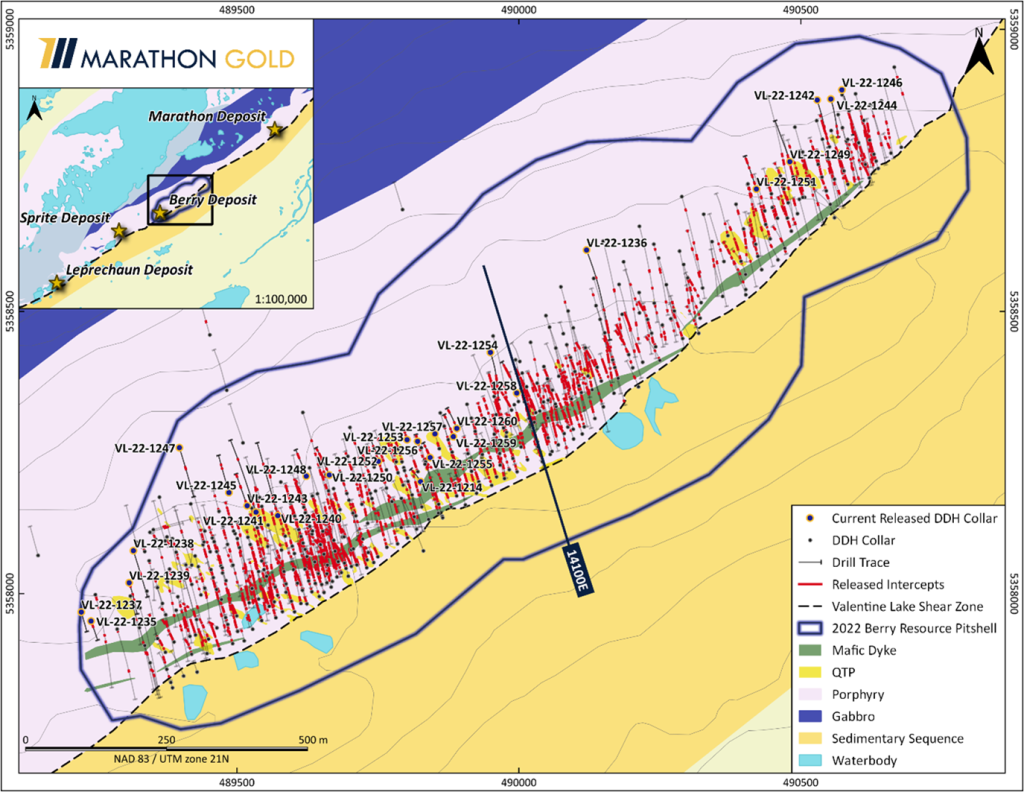
Figure 4: Long Section of the Berry Deposit (View NW) incorporating all drilling up to and including VL-22-1260, representing 115,554 metres, and assays above 0.3 g/t Au. New drill holes reported today are illustrated in blue.

Figure 5: Cross Section 14100E (View NE) with Significant (>0.7 g/t Au) Intercepts from DDH VL-22-1258, Berry Deposit, Valentine Gold Project.
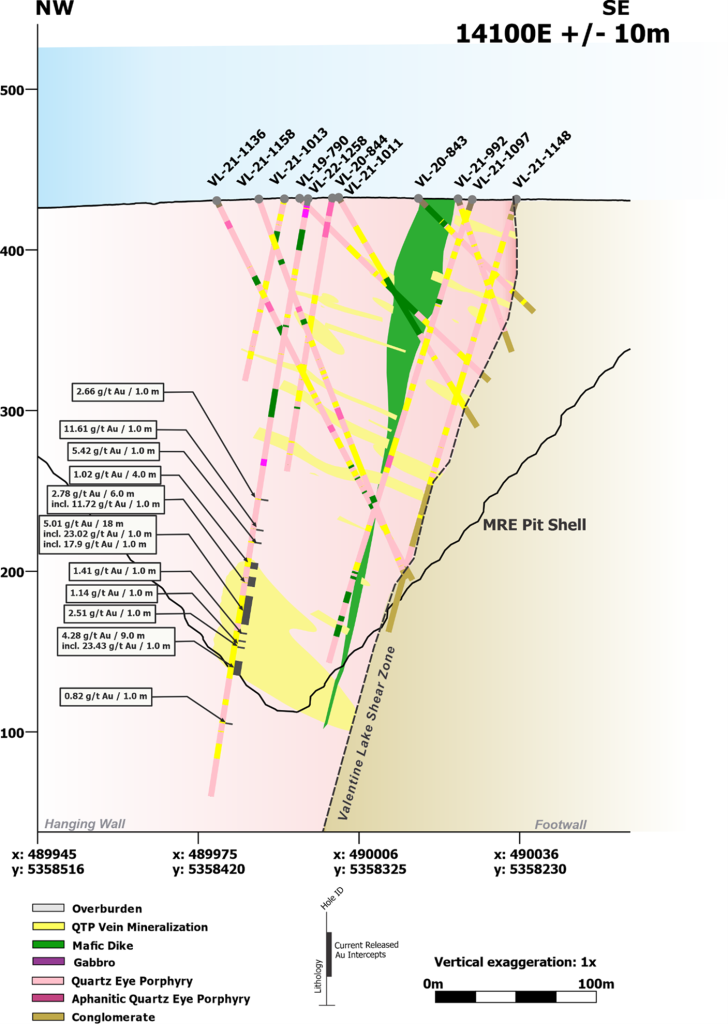
Figure 6: Cross Section 14110E (View NE) with Fire Assay Data from DDH VL-22-1258, Berry Deposit, Valentine Gold Project.
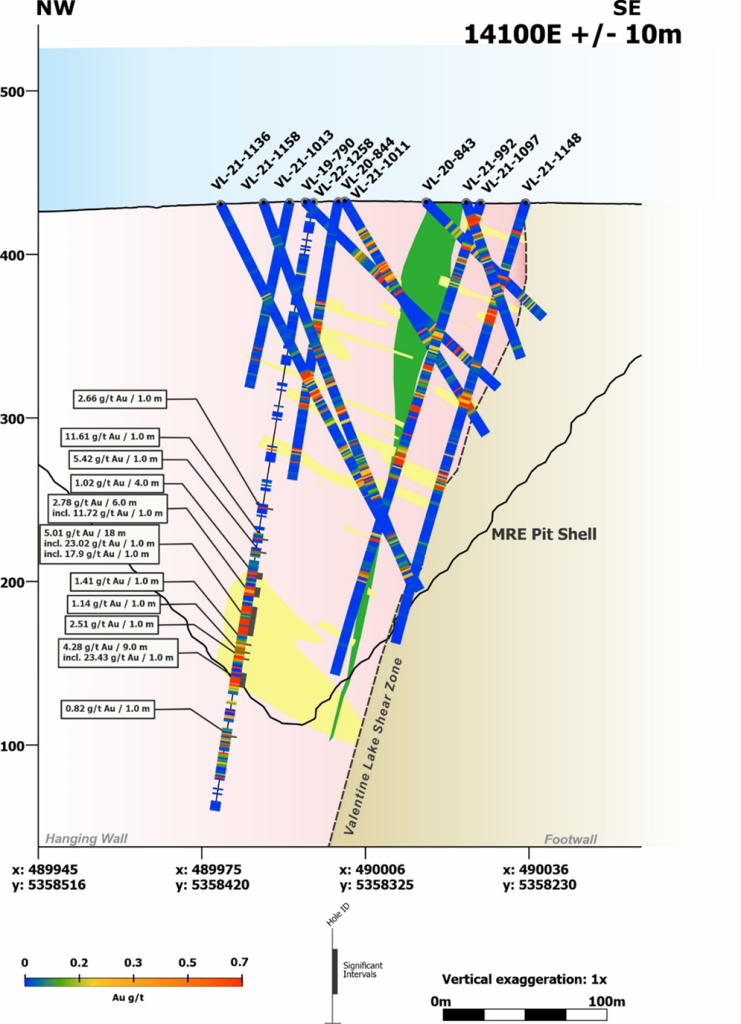
Note on the Presentation of Fire Assay Data
A more efficient, selective sampling procedure for fire assay of drill core has been adopted with the current report of data, illustrated by DDH VL-22-1258. This approach is supported by the current understanding of the geological model and mineralization of the deposit, and reduces sample costs, processing and turnaround time.
Qualified Persons
Disclosure of a scientific or technical nature in this news release was prepared under the supervision of Mr. David Ross, P.Geo. (NL), Vice President of Geology and Exploration for Marathon Gold Corporation and Mr. Nicholas Capps, P.Geo. (NL), Manager of Exploration for Marathon Gold Corporation. Exploration data quality assurance and control for Marathon is under the supervision of Jessica Borysenko, P.Geo (NL), GIS Manager for Marathon Gold Corporation. Mr. Ross, Mr. Capps and Ms. Borysenko are qualified persons under National Instrument (“NI”) 43-101. Mr. Roy Eccles, P.Geo. (NL), of APEX Geoscience Ltd. is a Qualified Person for purposes of NI 43-101, is independent of Marathon and the Valentine Gold Project, and has reviewed and takes responsibility for the updated July 2022 MRE prepared by John T. Boyd Company.
Quality Assurance-Quality Control
QA/QC protocols followed at the Valentine Gold Project include the insertion of blanks and standards at regular intervals in each sample batch. Drill core is cut in half with one half retained at site, the other half tagged and sent to Eastern Analytical Limited in Springdale, NL. All reported core samples are analyzed for Au by fire assay (30g) with AA finish. All samples above 0.30 g/t Au in economically interesting intervals are further assayed using metallic screen to mitigate the presence of coarse gold. Significant mineralized intervals are reported in Table 1 as core lengths and estimated true thickness (70 – 95% of core length), and reported with and without a top-cut of 30 g/t Au applied.
About Marathon
Marathon is a Toronto based gold company advancing its 100%-owned Valentine Gold Project located in the central region of Newfoundland and Labrador, one of the top mining jurisdictions in the world. The Project comprises a series of five mineralized deposits along a 32-kilometre system. A December 2022 Updated Feasibility Study outlined an open pit mining and conventional milling operation producing 195,000 ounces of gold a year for 12 years within a 14.3-year mine life. The Project was released from federal and provincial environmental assessment in 2022 and construction commenced in October 2022. The Project has estimated Proven Mineral Reserves of 1.43 Moz (23.36 Mt at 1.89 g/t) and Probable Mineral Reserves of 1.27 Moz (28.22 Mt at 1.40 g/t). Total Measured Mineral Resources (inclusive of the Mineral Reserves) comprise 2.06 Moz (29.23 Mt at 2.19 g/t) with Indicated Mineral Resources (inclusive of the Mineral Reserves) of 1.90 Moz (35.40 Mt at 1.67 g/t). Additional Inferred Mineral Resources are 1.10 Moz (20.75 Mt at 1.65 g/t Au). Please see the NI 43-101 Technical Report “Valentine Gold Project, NI 43-101 Technical Report and Feasibility Study” effective November 30, 2022, Marathon’s Annual Information Form for the year ended December 31, 2021 and other filings made with Canadian securities regulatory authorities available at www.sedar.com for further details and assumptions relating to the Valentine Gold Project.
MORE or "UNCATEGORIZED"
Kuya Silver Confirms High-Grade Silver-Gold Vein Mineralization at Umm-Hadid with Initial Drill Results up to 1483.9 g/t AgEq over 2 Metres
Kuya Silver Corporation (CSE: KUYA) (OTCQB: KUYAF) (FSE: 6MR1) is... READ MORE
First Phosphate Closes Final Tranche of Oversubscribed Private Placement
First Phosphate Corp. (CSE: PHOS) (OTCQX: FRSPF) (FSE: KD0) is... READ MORE
GFG Receives Final Payment from the Sale of its Rattlesnake Hills Gold Project
GFG Resources Inc. (TSX-V: GFG) (OTCQB: GFGSF) announces that i... READ MORE
Goliath Receives $1,730,882 Through Warrant Exercises, Inclusive Of Crescat Capital A Longtime Strategic And Cornerstone Shareholder
Goliath Resources Limited (TSX-V: GOT) (OTCQB: GOTRF) (FSE: B4IF)... READ MORE
Robex Pours First Gold at Kiniéro on Schedule and Budget
Highlights: Gold bar weighing 2.64 kilograms (85 oz) poured in th... READ MORE












